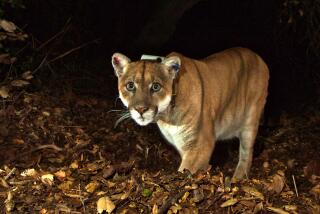A gnawing question answered: It’s a capybara roaming Paso Robles
It started last month when workers at a Paso Robles wastewater treatment plant noticed what appeared to be a giant rodent roaming the facility.
The creature eventually swam toward the Salinas River and disappeared from sight, but not before worker Nick Kamp had taken a few photos. He and a co-worker called the California Department of Fish and Game to report what they had seen. Responding wardens used the pictures to confirm that the animal was in fact a capybara — an adult they believe weighs 100 to 120 pounds.
This week, Kamp’s photos went viral on the Internet as news spread of the rare sighting. Capybaras are native to South America and usually aren’t found in the United States except in zoos.
“He seemed pretty content,” Kamp said of the creature. “He was pretty happy in there.”
The semiaquatic capybara is the world’s largest rodent and prefers swampy, marshy habitats. It’s illegal to own a capybara as a pet in California, so authorities believe the animal either was released by or escaped from an owner a few years ago and has been roaming Paso Robles ever since.
“Somebody probably brought it in as a pet, and they either got away or people couldn’t deal with it anymore,” Fish and Game spokesman Andrew Hughan said.
The rodents — which can grow to the size of a large dog — aren’t dangerous, “just weird-looking,” Hughan said.
It’s not the first time a capybara has been spotted in Paso Robles. Game wardens received a report about three years ago of a capybara in a pond near Hunter Ranch Golf Course, but because there were no other sightings and beavers live in the area, they thought it was a mistake.
Eight months later, a man said a large rodent-like creature scared his horses away and started eating the hay he was feeding them. The man eventually fired a gun in the direction of the animal as it chased his dog. He then called wildlife officials after it left the property. Wardens confirmed that footprints at the scene were that of a capybara.
No other sightings were reported until three weeks ago at the wastewater plant, though Kamp said another co-worker said he had seen a strange animal at the plant but wasn’t sure what it was.
No other capybara sightings have been reported in California, Hughan said. The rodents have been spotted in other states over the years. In Florida, sightings are common; some experts believe a wild capybara population exists after a few rodents escaped from a research facility in 2001.
Wardens are prepared to set traps for the Paso Robles capybara, but because the animal appears healthy and isn’t harming the area, the department’s policy is to allow it to remain wild, Hughan said. That could change, he warned, if hunters and trappers go after the animal.
“You can’t hunt that thing,” Hughan said. “If we see people out there with nets and traps trying to catch it, we may take a more aggressive stance for the protection of the animal.”
Though capybaras aren’t predatory toward humans, experts said that anyone who spots the rodent shouldn’t approach it.
“Like any wild animal, they’re going to defend themselves, so we wouldn’t want anybody to get close to it,” said Lt. Todd Tognazzini of Fish and Game.
The ultimate goal, officials said, is for the animal to be left alone.
“We hope that it lives a happy capybara life in Paso Robles,” Hughan said.
More to Read
Start your day right
Sign up for Essential California for news, features and recommendations from the L.A. Times and beyond in your inbox six days a week.
You may occasionally receive promotional content from the Los Angeles Times.







